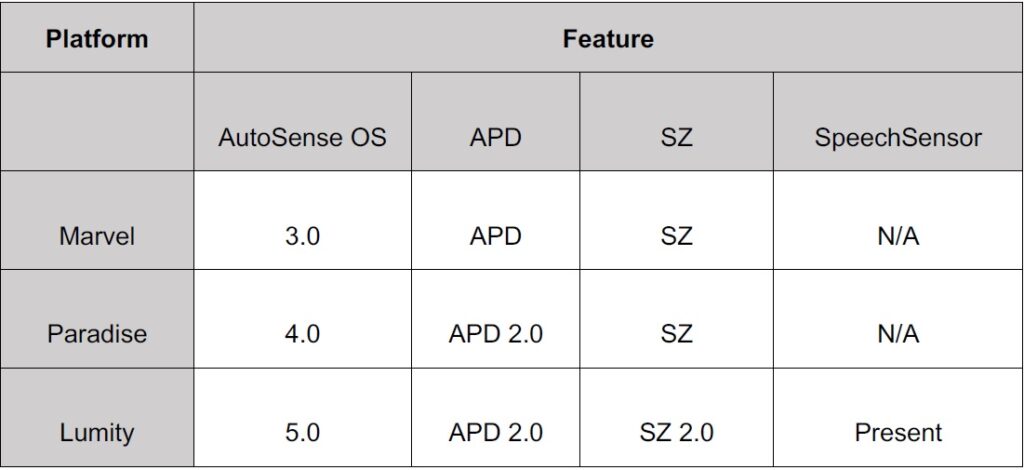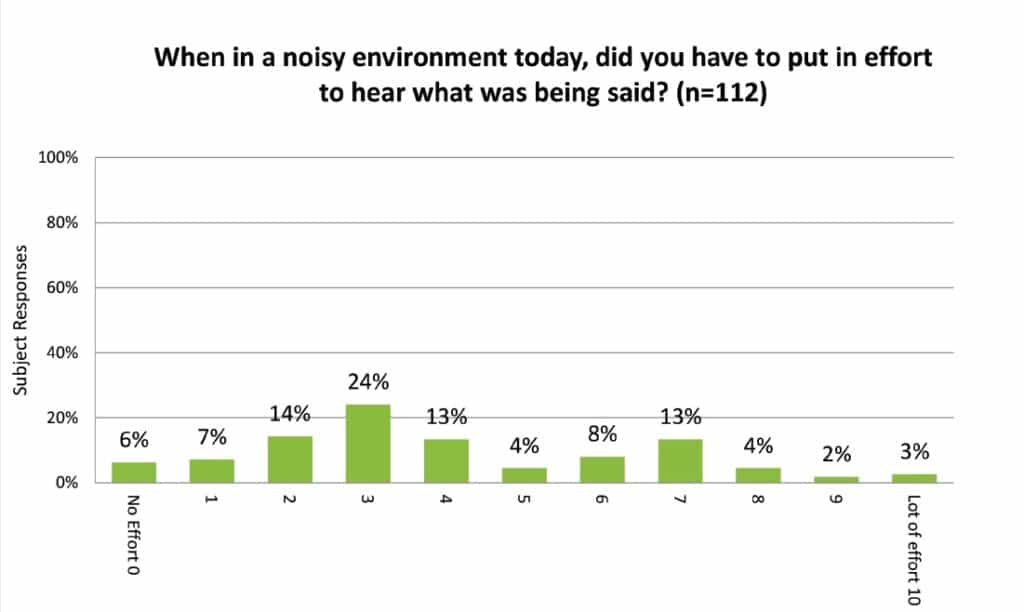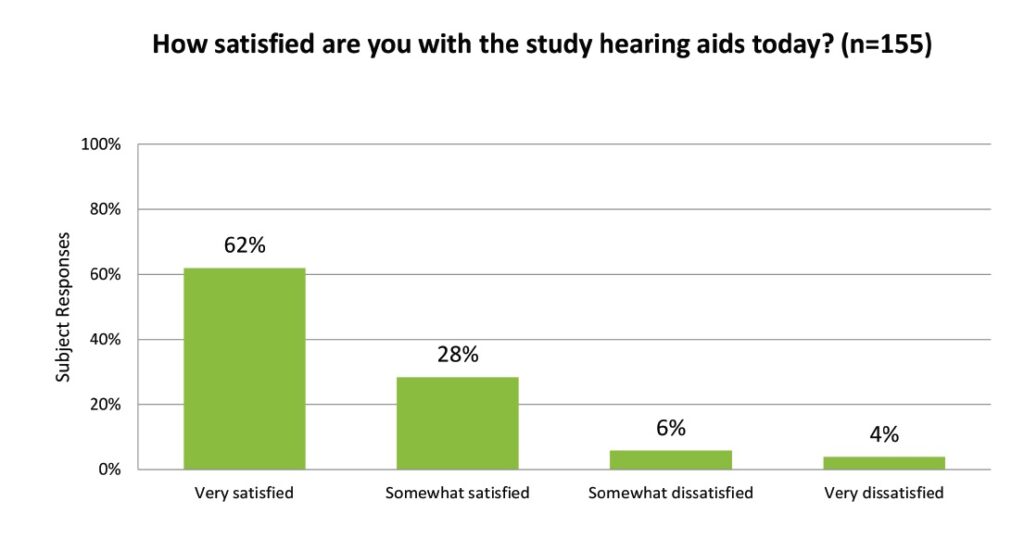This article focuses on the qualitative methods, data, and results from a trial that uses ecological momentary assessment (EMA) to measure subjective listening effort
By Megan Adler, AuD
The majority of conversations happen in front of us, but according to Walden et al,1 speech is on the side or behind us 20% of the time. In some of those instances when speech is not in front, we don’t want to or can’t move our head. This is when an automatic program with steered beamforming is beneficial. SpeechSensor is a new feature with Phonak Lumity hearing aids that determines if the dominant talker is located to the front, back, or side of the listener. By detecting the direction of incoming speech, SpeechSensor steers the beamformer to a more appropriate setting that is better suited to a listener’s needs.
Alongside SpeechSensor, Lumity also launched StereoZoom 2.0 (SZ 2.0), an update to Phonak’s binaural beamformer, StereoZoom (SZ). SZ 2.0 introduces three updates to SZ; a smoother transition into the Speech in Loud Noise (SPiLN) program, which is a part of AutoSense OS 5.0; and two updates to the activation criteria for the SPiLN program—the requirement of only needing one hearing aid to meet the criteria to switch into this program, and the ability for activation of the program at a lower noise level compared to the earlier version.

The activation of SZ 2.0 at a lower noise level is beneficial because research has indicated that the typical “speech in noise” environment is around 68 dB with a positive signal-to-noise ratio.2,3
Two previous studies showed that advancements in the Paradise platform reduced subjective listening effort. One study investigated the benefits of updating Phonak’s proprietary fitting formula, Adaptive Phonak Digital (APD), to APD 2.0.4 The other study looked at the benefits of Speech Enhancer and Dynamic Noise Cancellation, which are features that were introduced with AutoSense OS 4.0 in Paradise hearing aids.5 Lumity builds on Paradise, with the upgrade to AutoSense 5.0 and the addition of SpeechSensor and SZ 2.0. Table 1 summarizes Lumity and the two previous Phonak hearing aid platforms.
Latzel et al6 was the first to show the benefits of SpeechSensor in a lab setting, finding an 11% reduction in subjective listening effort in noise when speech is from the side and back. This was further supported by additional lab testing conducted by Adler and Seitz-Paquette.7 Obtaining data from both subjective and objective outcome measures provides a more holistic documentation of hearing aid benefits.8 With that in mind, they also focused on the subjective benefits of Lumity in the real world.7 Through the use of ecological momentary assessment (EMA) and open-ended feedback, the investigator was able to capture the entire experience from the hearing aid user in their own words. Studies have shown that EMA apps can successfully gather ecologically valid data for hearing aid users.9
Listening effort in noise and hearing aid satisfaction ratings were collected via daily retrospective surveys facilitated by an EMA app over a two-week home trial among adults with moderate to moderately severe hearing loss. This article primarily focuses on the qualitative methods, data, and results from the home trial; to learn more details about additional objectives of this study, including in-lab study methods and results, see Adler and Seitz-Paquette.7

Methodology
This clinical investigation was an interventional study executed at Phonak Audiology Research Center (PARC) in Aurora, Illinois. For the home trial, participants were fit with Audéo Lumity 90 RT hearing aids in a single-arm trial.
Fourteen participants (6 male, 8 female) with moderate to moderately severe hearing loss participated in the study. The average age was 75 years, with a range of 65-92 years. All participants had experience with hearing aids, defined as at least one year of daily hearing aid use.
Participants used an EMA app on either their own Android smartphone or a loaner phone provided by the researcher. During the two-week home trial, participants received a daily two-question retrospective survey via the app at an evening time of their choosing, which was established at the beginning of the home trial. The investigator instructed them to respond to the survey questions and provide open-ended feedback in written and voice-note formats.
The first daily retrospective question, “When in a noisy environment today, did you have to put in a lot of effort to hear what was being said?” was extracted from a subjective listening effort questionnaire previously used.10 This question had a 10-point response scale varying from “No effort” to “Lot of effort,” with the additional option to indicate they were not in a noisy environment that day. On the rating scale, the lower the number, the better. If the participant was in a noisy environment, then a comment section was triggered in the app, “Please type or leave a voice note to describe more about your experience in the noisy environment (e.g., where you were and what made it require effort).”
The second daily retrospective question was, “How satisfied are you with the study hearing aids today?” The response options were: very satisfied, somewhat satisfied, somewhat dissatisfied, and very dissatisfied. The participant then had the opportunity to leave another open-ended comment. The prompt for this comment read, “Please type or leave a voice note for any other details you would like to mention about the day.”

Results
A total of 163 daily in-field surveys were returned from the two-week home trial, giving a daily assessment of the participant’s listening effort in noisy environments and their satisfaction with their hearing instruments throughout the day. In 31% of the daily responses, the participants reported they spent no time in noisy environments throughout their day. However, for those that did report encountering noisy environments, 65% of the daily responses had a rating less than 5 on the 10-point categorical scale. This indicates that when noise was present, speech understanding was generally not effortful (Figure 1). Participants were overwhelmingly satisfied with the instruments, with 90% of all daily surveys reporting satisfaction (Figure 2).

Surveys also captured open-ended feedback from participants (in written or voice-note format) to provide context for their categorical responses. First, the comments from the home trial surveys (including all voice notes) were transcribed and sorted into “positive” and “negative” categories. Next, an online word cloud generator (wordclouds.com) was used to generate a one-word cloud for each category (Figure 3 and Figure 4). Finally, themes were extracted from these word clouds.

For the positive comments, the top themes were: hear(ing), hearing aids, noise, conversation, people, and clearly. Participants indicated in the free-field comments in the EMA app that there were various situations in which the hearing aids helped them hear conversations well and better than their current hearing aids. For example, “I was at an outdoor restaurant, and a band was playing. My husband and I were talking, and I could hear him well.” In addition, “I was at an exercise class and heard the instructor’s voice clearly, even though there was music in the background.” Also, “I was in a restaurant and could hear the waitress clearly, as well as my lunch partner and other patrons.” One participant summed up their daily satisfaction with, “I hear very well with these aids. Sound is clear and distinct.”
For the negative comments, the top themes were: noise, hearing, volume, difficulty, concentrate, and loud. Some of these comments mentioned during the home trial are themes that often arise from those with hearing loss in difficult listening situations. For example, “While in the restaurant, (I) had to lower the volume of the aids a few times because of the noise level. By doing so, I had some difficulty communicating with the others at my table.” One important limitation of this study was that the participants were not able to use the additional fine-tuning available in the myPhonak app (e.g., noise reduction, speech focus, equalizer presets) because the hearing aids were already paired with the EMA app. Many negative comments relate to factors that could be addressed through use of the myPhonak app, highlighting the importance of individualization to hearing aid users.
Although participants often indicated not experiencing noisy situations at all during the day, results also show a high degree of satisfaction and low subjective listening effort with the Audéo Lumity hearing aids when noise is experienced. The qualitative data captured by the EMA app, along with the subjective and objective data obtained in the lab, yields results that indicate the features in Audéo Lumity provide benefits in real-world situations. While laboratory data is an important tool to benchmark performance under ideal conditions, in-field, qualitative data provides insight into how hearing aids benefit participants in the situations that matter most to them. The qualitative results presented in this paper add important context to the benefits documented in the lab and could not be obtained without allowing participants to use the hearing aids in their normal daily lives.HR

Megan Adler, AuD, is a research audiologist with Sonova. She joined Sonova in 2008 and has worked in technical support as part of the customer success team and with US validations. Adler’s audiology work history includes fitting and dispensing for adults and pediatrics at an Otolaryngologist (ENT) office.
References:
- Walden BE, Surr RK, Cord MT, Dyrlund O. Predicting hearing aid microphone preference in everyday listening. Journal of the American Academy of Audiology. May 2004;15(5):365-96.
- Smeds K, Wolters F, Rung M. Estimation of signal-to-noise ratios in realistic sound scenarios. Journal of the American Academy of Audiology. 2015;26(2):183–196.
- Wu YH, Stangl E, Chipara O, Hasan SS, Welhaven A, Oleson J. Characteristics of real-world signal to noise ratios and speech listening situations of older adults with mild to moderate hearing loss. Ear and Hearing. 2018;39(2):293–304.
- Wright A. Adaptive Phonak digital 2.0 – next-level fitting formula with adaptive compression for reduced listening effort. Field Study News. 2020. Accessed April 2023. Retrieved from; https://www.phonak.com/en-us/professionals/guides/evidence-library.
- Appleton J. AutoSense OS 4.0 – significantly less listening effort and preferred for speech intelligibility. Phonak Field Study News. 2020. Accessed April 2023. Retrieved from; https://www.phonak.com/en-us/professionals/guides/evidence-library
- Latzel M, Lesimple C, Woodward J. New implementation of directional beamforming configurations shows improved speech understanding and reduced listening effort. Phonak Field Study News. 2020. Accessed April 2023. Retrieved from; https://www.phonak.com/en-us/professionals/guides/evidence-library
- Adler M, Seitz-Paquette K. Advancements in beamformer technology demonstrate an advantage of a steered beamformer vs. static for off-axis speech in noisy environments. Phonak Field Study News. 2020. Accessed April 2023. Retrieved from; https://www.phonak.com/en-us/professionals/guides/evidence-library
- Mendel LL. Objective and subjective hearing aid assessment outcomes. American Journal of Audiology. 2007;16,118-129.
- Holube I, von Gablenz P, Bitzer J. Ecological momentary assessment in hearing research: current state, challenges, and future directions. Ear and Hearing. 2020;(4):Suppl.1:79S-90S.
- Hornsby BW. The effects of hearing aid use on listening effort and mental fatigue associated with sustained speech processing demands. Ear and Hearing. 2013;(34),523–534.


